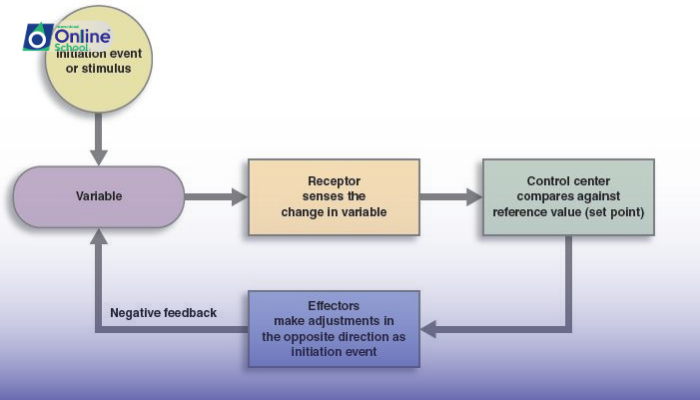
Learning Outcomes
By the end of this lesson, students will be able to:
i. Explain the concept of feedback systems and their role in homeostatic mechanisms.
ii. Differentiate between negative and positive feedback systems.
iii. Identify examples of negative feedback loops in the body's regulatory processes.
iv. Understand the significance of feedback systems in maintaining stability and preventing runaway conditions in biological systems.
Introduction
Homeostatic mechanisms, the elaborate control systems that maintain a stable internal environment in living organisms, rely on feedback loops to ensure efficient and precise regulation. Feedback systems are communication pathways that transmit information about the current state of a physiological parameter back to the control center, allowing it to make adjustments to maintain the desired set point.
i. The Information Highway: Feedback Systems in Action
Feedback systems consist of three main components:
Sensor: Detects changes in the internal environment and sends signals to the control center.
Control Center: Analyzes the sensor's signals and determines the appropriate response.
Effector: Receives instructions from the control center and carries out the necessary actions to bring the internal environment back to the set point.
ii. Two Sides of the Same Coin: Negative and Positive Feedback
Feedback systems can be categorized as either negative or positive feedback loops:
Negative feedback: The most common type of feedback system, it acts to counteract changes and maintain stability. In negative feedback, the output of the system opposes the initial change, bringing the variable back towards the set point. For instance, the regulation of body temperature by sweating is an example of negative feedback.
Positive feedback: A less common type of feedback system, it amplifies the initial change, leading to a further increase or decrease in the variable. In positive feedback, the output of the system reinforces the initial change, causing the variable to move further away from the set point. For instance, the blood clotting process is an example of positive feedback, as it accelerates the formation of a clot to prevent excessive blood loss.
iii. Negative Feedback: The Guardian of Stability
Negative feedback loops are the cornerstone of homeostatic mechanisms, ensuring stability and preventing runaway conditions in biological systems. They act like a thermostat, constantly monitoring and adjusting the internal environment to maintain the desired set point. Examples of negative feedback loops in the body include:
Body temperature regulation: When the body temperature rises, sweat glands release sweat to cool the body, bringing the temperature back to the set point.
Blood sugar regulation: When blood sugar levels rise, the pancreas releases insulin, a hormone that promotes glucose uptake by cells, lowering blood sugar back to the set point.
Blood pressure regulation: When blood pressure rises, blood vessels dilate to accommodate increased blood flow, lowering pressure back to the set point.
iv. Positive Feedback: A Role in Amplifying Change
While negative feedback is prevalent in homeostatic mechanisms, positive feedback plays a crucial role in specific biological processes, particularly those involving rapid amplification or acceleration. Examples of positive feedback loops in the body include:
Blood clotting: When a blood vessel is injured, platelets are activated and release clotting factors. These clotting factors trigger the formation of a fibrin clot, which encloses the injured area and prevents further blood loss.
Childbirth: During childbirth, uterine contractions increase as labor progresses. These contractions stimulate the release of oxytocin, a hormone that further intensifies contractions, leading to the expulsion of the baby.
Feedback systems, whether negative or positive, are fundamental components of homeostatic mechanisms, enabling organisms to maintain a stable internal environment and respond effectively to changes. Understanding the principles of feedback loops and their diverse roles in biological systems is essential for appreciating the remarkable complexity and adaptability of life.